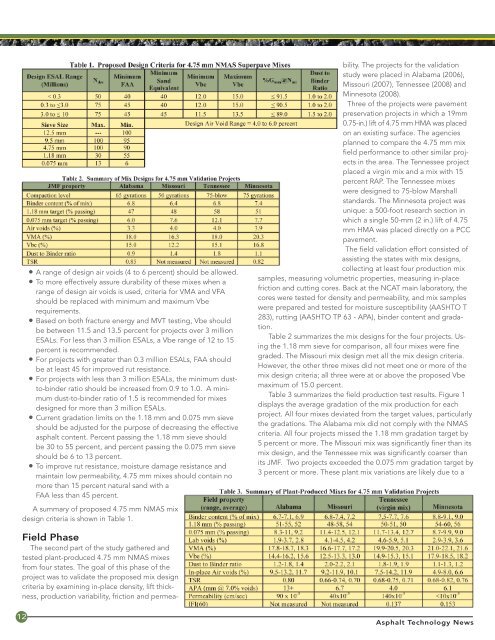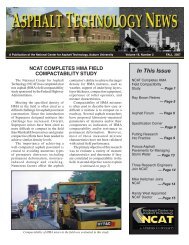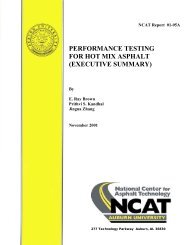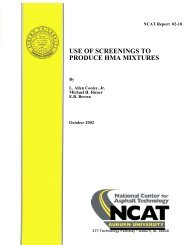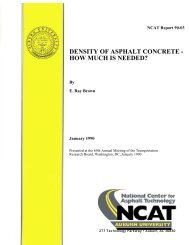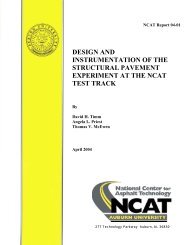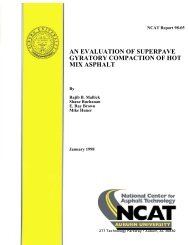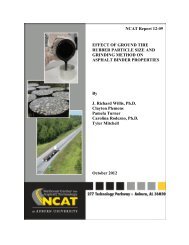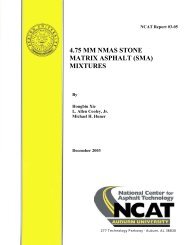Asphalt Technology News - Auburn University
Asphalt Technology News - Auburn University
Asphalt Technology News - Auburn University
You also want an ePaper? Increase the reach of your titles
YUMPU automatically turns print PDFs into web optimized ePapers that Google loves.
• A range of design air voids (4 to 6 percent) should be allowed.• To more effectively assure durability of these mixes when arange of design air voids is used, criteria for VMA and VFAshould be replaced with minimum and maximum Vberequirements.• Based on both fracture energy and MVT testing, Vbe shouldbe between 11.5 and 13.5 percent for projects over 3 millionESALs. For less than 3 million ESALs, a Vbe range of 12 to 15percent is recommended.• For projects with greater than 0.3 million ESALs, FAA shouldbe at least 45 for improved rut resistance.• For projects with less than 3 million ESALs, the minimum dustto-binderratio should be increased from 0.9 to 1.0. A minimumdust-to-binder ratio of 1.5 is recommended for mixesdesigned for more than 3 million ESALs.• Current gradation limits on the 1.18 mm and 0.075 mm sieveshould be adjusted for the purpose of decreasing the effectiveasphalt content. Percent passing the 1.18 mm sieve shouldbe 30 to 55 percent, and percent passing the 0.075 mm sieveshould be 6 to 13 percent.• To improve rut resistance, moisture damage resistance andmaintain low permeability, 4.75 mm mixes should contain nomore than 15 percent natural sand with aFAA less than 45 percent.A summary of proposed 4.75 mm NMAS mixdesign criteria is shown in Table 1.bility. The projects for the validationstudy were placed in Alabama (2006),Missouri (2007), Tennessee (2008) andMinnesota (2008).Three of the projects were pavementpreservation projects in which a 19mm0.75-in.) lift of 4.75 mm HMA was placedon an existing surface. The agenciesplanned to compare the 4.75 mm mixfield performance to other similar projectsin the area. The Tennessee projectplaced a virgin mix and a mix with 15percent RAP. The Tennessee mixeswere designed to 75-blow Marshallstandards. The Minnesota project wasunique: a 500-foot research section inwhich a single 50-mm (2 in.) lift of 4.75mm HMA was placed directly on a PCCpavement.The field validation effort consisted ofassisting the states with mix designs,collecting at least four production mixsamples, measuring volumetric properties, measuring in-placefriction and cutting cores. Back at the NCAT main laboratory, thecores were tested for density and permeability, and mix sampleswere prepared and tested for moisture susceptibility (AASHTO T283), rutting (AASHTO TP 63 - APA), binder content and gradation.Table 2 summarizes the mix designs for the four projects. Usingthe 1.18 mm sieve for comparison, all four mixes were finegraded. The Missouri mix design met all the mix design criteria.However, the other three mixes did not meet one or more of themix design criteria; all three were at or above the proposed Vbemaximum of 15.0 percent.Table 3 summarizes the field production test results. Figure 1displays the average gradation of the mix production for eachproject. All four mixes deviated from the target values, particularlythe gradations. The Alabama mix did not comply with the NMAScriteria. All four projects missed the 1.18 mm gradation target by5 percent or more. The Missouri mix was significantly finer than itsmix design, and the Tennessee mix was significantly coarser thanits JMF. Two projects exceeded the 0.075 mm gradation target by3 percent or more. These plant mix variations are likely due to aField PhaseThe second part of the study gathered andtested plant-produced 4.75 mm NMAS mixesfrom four states. The goal of this phase of theproject was to validate the proposed mix designcriteria by examining in-place density, lift thickness,production variability, friction and permea-12<strong>Asphalt</strong> <strong>Technology</strong> <strong>News</strong>


